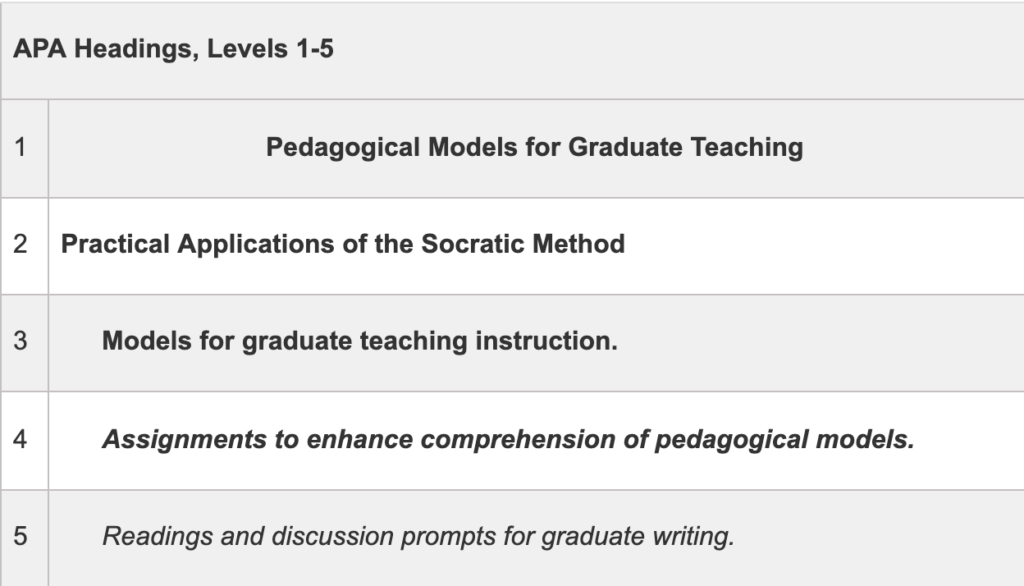APA Headings: How to Use and Format
There are many elements to consider when writing a dissertation. While research and content tend to be first and foremost on our minds when approaching a project of this depth and magnitude, it is also important to think about style and formatting. When writing your dissertation, keep in mind visual elements like APA headings that are vital for organizing and structuring your document.
Mastering APA style is a tall order, so much so that it can feel like learning a new language. In a way, you are. APA headings are integral to academic research, and (believe it or not), they’re designed to add clarity to academic writing and make it easier to read. Before getting started with writing and diving into things like APA headings, it’s a good idea to check with your dissertation advisor about the specific style and conventions used by your department.
These are a few frequently asked questions about APA headings:
- What is APA style?
- What are APA headings?
- How do I use APA headings?
- Can I use formatting software for APA headings?

What is APA Style?
Let’s start at the beginning! APA style is the rulebook that governs formatting for assignments, dissertations, and publications in a variety of professional and academic fields. APA stands for the American Psychological Association, and while APA formatting was originally created for use in the psychological, sociological, and behavioral sciences, it was adopted by academic fields as wide-ranging as STEM and education.
APA style is one of several style guides, and it’s probably not the one you grew up using (that’s MLA, from the Modern Language Association). In addition to APA and MLA, there is also Chicago/Turabian style and dozens of less popular and deeply specific styles used around the world. It is also worth noting that many universities have their own versions of APA, so it’s worth your time to find out about the expectations at your university.
As an academic, I used MLA format throughout my entire education, and then I was promptly hired by a STEM university and expected to teach APA exclusively. While there was definitely a learning curve, I like APA and find it to be a fairly intuitive style. From an organizational perspective, it makes a lot of sense, and the American Psychological Association publishes regular updates to keep up with the fast pace of technology. The 7th and most recent edition of The Publication Manual of the American Psychological Association was published in 2019.
What Are APA Headings?
APA headings are the most visually distinctive element of APA style. A quick scan of an article or dissertation makes it clear whether or not that document has been written in APA style. APA headings are a key aspect of the classification structure that makes documents written in APA easy to follow.

APA headings are ordered by level as part of a system that prioritizes research using a top-down model. There are a total of five levels of APA headings, and they classify information in descending order, or subordination. The centering and styling of the font (using boldface or italics) changes according to level, which makes it easier to discern what level you’re at as you are reading.
Using APA Headings
There’s no getting around it: using APA headings takes some practice. It’s a good idea to have a model or template to help you get the hang of it when you’re first getting started. To begin, it helps to know how the levels of APA headings are visually distinctive.
- Level One This indicates a new section. Every section in the dissertation, except for the introduction, features a centered, bold-faced heading. The text beneath the heading is a new paragraph.
- Level Two This is a subsection. Instead of being centered, this heading is aligned to the left and bold-faced. The text beneath a subsection also begins with a new paragraph.
- Level Three This level is where it can start to get tricky. A Level Three APA heading is used to label a subsection of a subsection. The heading for Level Three is aligned to the left, bold-faced, and italicized, with the text below starting a new paragraph.
- Level Four Like Dante, we descend. Level Four APA headings should be indented and bold-faced. There should also be a period at the end of the heading, and text on the same line as the heading (no extra space needed).
- Level Five Formatting for Level Five is identical to Level Four, but italicized.
APA Heading Examples

Additional APA headings, called section labels, are used for abstracts, title pages, references, and appendices. Basically, any section that gets its own page. Additional optional sections, like dedications or acknowledgments, also fall under section labels.
Software for APA Headings
As a professor teaching graduate students, I am often asked for my thoughts on APA software for citation and formatting things like APA headings. Students want to know if I recommend it for dissertations and if I use it for my own research projects. Personally, APA formatting software is not something that I use, but I think it can be very helpful if it’s used appropriately, and that’s a significant caveat that many graduate students need to take into consideration.
Even with the support of software, it’s essential to have a strong working knowledge of APA (or seek the advice of a specialist who does). Software is fallible and also subject to human error, so you’ll need to be able to review your documents and know for yourself whether your APA headings are formatted correctly or not. Unfortunately, there are no shortcuts! When your dissertation finally goes to your committee, it’s important for everything to be perfect.
Even though it has been almost ten years since I wrote and defended my dissertation, I still remember how much work went into formatting and catching style errors before it went to the graduate college at my university for final approval. Dissertations are subjected to a lot of scrutiny (and understandably so!) before they’re sent off to be bound. After putting in all that time and effort into your research, formatting for style and APA headings is one last sprint before the finish line.
 Waiting to Get Your Dissertation Accepted?
Waiting to Get Your Dissertation Accepted?







